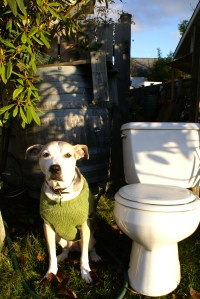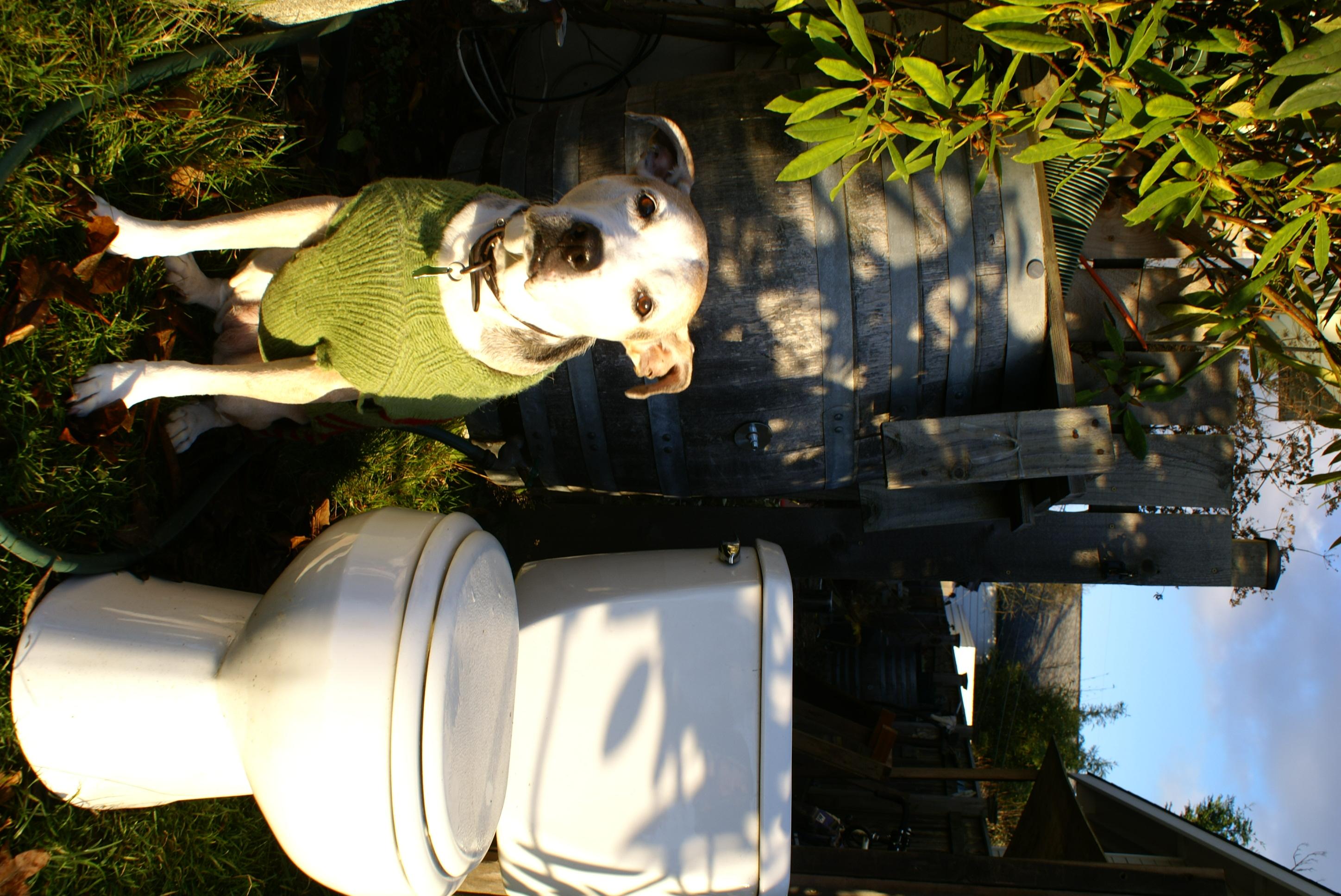
Photo by Chris LaRoche.
This piece, cross-posted from Sightline, is part of the research project Making Sustainability Legal.
Call me a dreamer. I want to flush with rainwater. Rain barrels already anchor my downspouts. I want to hitch them to my toilet tank. It would save me money and leave my city’s drinking water for better uses.
Yet so far local plumbing rules aren’t helping me, or thousands of others, make the rain-barrel connection. It’s not so much that rules prohibit it, but that even local authorities do not really understand what the rules mean. A little clarification — and publicity — would go a long way.
Already, outside my house in Seattle’s Ballard neighborhood, I’ve managed to irrigate my Victory Garden all summer from nothing but the 500 gallons of rain I collect in 10 barrels. During the other three seasons, though, the garden doesn’t need extra moisture, so my barrels sit unused and, often, full to the brim.
So I’m flushing my toilet with pure, treated drinking water that’s piped scores of miles from the Cascades while I’ve got hundreds of gallons of free, naturally delivered, and naturally replenished rain stockpiled just outside my bathroom wall. Perhaps you now understand the intensity of my dream? A Rain Water Toilet Flush system (RWTF)!
I’m a perfect candidate: I live in a 1920 single-floor, 800-square-foot fisherman’s shack, so everything is down low to the ground and close together. My girlfriend and I have been doing our best to conserve water. Our consumption this past winter, for example, was half of what we used a year earlier. The U.S. average is 70 gallons per person per day, according to the Environmental Protection Agency. According to Seattle Public Utilities, we got our average daily water consumption down to 25 gallons apiece. By connecting our rain barrels to the toilets, we could reduce our water use by another nine gallons a day (six flushes a day times 1.6 gallons per flush). Also, we could stop being one of those stinky “if it’s yellow, let it mellow” households!
A toilet can account for anywhere from 27 percent (older toilets) to 8 percent (low-flow toilets) of household water use. There are over 130,000 single-family homes in my city alone. If only 10 percent of these homes used such a setup to reduce their municipal water use by a quarter, it would save more than 645,000 gallons of water a day, or 19 million gallons a month. Extend that math across America, and the savings multiply.
Back to my personal challenge: I have a single toilet situated just a few feet above ground level. Connecting it to my rain barrels should be easy, right?
Wrong.
Unfortunately, it’s not as simple as drilling a hole through the wall and attaching the toilet to the barrel (aka “Experiment No. 1” — don’t tell the plumbing inspector, but I may have already tried that). It involves principles of hydro- and seismic engineering. For a gravity-fed system, you need height. Water weighs 8.3 pounds a gallon. A full 50-gallon barrel weighs more than 400 pounds. Hoisting it to an adequate height, in earthquake country, you need some reinforced structure. Not too complicated, but definitely not simple.
And then there’s the permitting. Both Washington State and Seattle allow rainwater catchment systems for indoor, non-potable use, but finding out how it’s done and what the permits are sure ain’t easy. Trying to do so led me on a three-year wild goose chase that finally, I hope, is coming to a fruitful conclusion.
For answers, I looked to Portland, where examples of RWTF systems are almost as common as microbrews and bicycles. The Portland Bureau of Planning and Sustainability website includes some interesting and practical examples of single-family RWTF systems. A call to the office put me in touch with Valerie Garrett, who staffs the Green Hotline. After I told her of my quest, she referred me to Pat Lando, a local contractor who has been designing and installing rainwater systems for 10 years.
Lando clarified everything: Early on, he was stymied by the high costs of household rainwater systems, so he developed his own kit. He hesitated to give estimates, but when pressed, he suggested $2,600 for an installed, effective system. The main costs are the cisterns and installation, so if you’re handy it could be much cheaper. (I later found a plumber in Seattle who said the materials cost between $1,700 and $2,400.)
Not only that, to maximize savings and return in investment, I learned that I could go beyond a RWTF system, to a “Rainwater for Non-potable Household Use” (RNHU) system. That little three-letter switch in acronyms would allow me to use rainwater not only for the largest consumer of indoor water (the john) but also for the second-largest: the washing machine! Doing so would cut household water use not by 27 percent, but by half!
There was good news, too, on the plumbing codes: Both Oregon and Washington (and many other states around the country) use the International Built Plumbing Code, so I could use an Oregon design — if only I could get the proper permissions.
For these, I went to Larry Fay of the King County Department of Public Health, who explained that for $210, I could get a permit for a standard plumbing fixture and three outlets to use rain water. (I would only use two outlets: toilet and washing machine.) The price includes review. Once my plan passes review, I can legally start tapping my rain barrels for indoor use. Or I can get a bigger storage unit, a cistern for indoor use. Plumbing authorities’ main concern is that your rainwater system doesn’t cross-connect with the municipal lines, allowing contamination of city drinking water.
But there’s another key point: Only in 2009 did the Washington Department of Ecology allow rainwater catchment systems at all; before that, capturing and storing rainwater violated water resource law. This is a common occurrence in Western states — so before you go looking for that magical connection, make sure your local and state authorities allow it!
That said, some areas are going even further than the RNHU. King County, I’m told, will soon allow rainwater catchment systems to provide household potable water. In my town, at least, the “someday” when we’ll make the rain-barrel connection is drawing closer all the time, for the regulations, the dreamers, and me.



